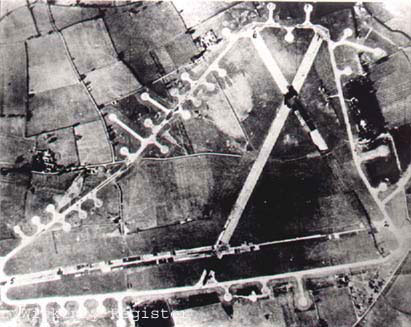
Construction Begins
The airfield followed the standard Bomber Command layout, having three concrete runways and a perimeter track. The main runway 09/27 ran east/west along the southern side with the other two runways 03/21 & 16/34, crossing towards the north of the site with thirty six aircraft dispersals around the perimeter track. Two hangars of the steel T2 type were erected one to the north of the airfield and one to the south of the main runway, a third hangar of the B1 type was built later in 1943 and this was located at the north end of the technical and domestic site which was situated on the eastern side extending towards the village of Holton cum Beckering. The bomb storage area was constructed in a slight depression at the south west corner of the airfield. Building was completed in September 1942 and the airfield came under the control of No 1 Group Bomber Command and initially opened as a satellite station to RAF Binbrook. Later in December 1943 RAF Wickenby became No 14 Base substation to RAF Ludford Magna. Unlike most other RAF Stations, RAF Wickenby never had its own Station Badge.
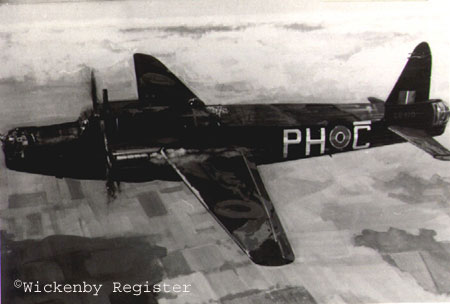
12 Squadron Moves In
During September 1942 under the Station Commander W/Cdr Dabinett, 12 Squadron moved to RAF Wickenby from their base at RAF Binbrook, bringing with them their Wellington Bombers in which they flew a number of missions. In November 1943, 12 Squadron became the second Squadron in 1 Group to be equiped with the AVRO Lancaster and on 12 January 1942 they were able to put nine Lancasters in the air as part of a force of 72 medium and heavy bombers which attacked an oil refinery in Essen.
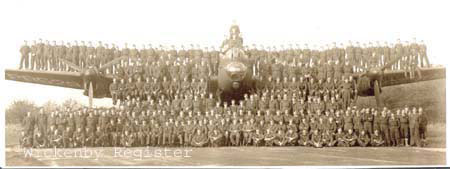
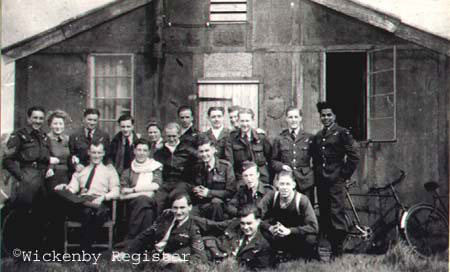
626 Squadron Formed
On 7 November 1943 626 Squadron was formed by the expansion of 12 Squadron’s C Flight. To accommodate the extra personnel generated by the formation of the new Squadron, a new dispersed site was built to the south of the airfield. This site would accommodate both air and ground crew and it covered a large area between the villages of Fulnetby and Rand.
The two Squadrons took part in many major raids on enemy targets such as Mailey le Camp, Nuremburg and also Bomber Commands last main operation of the war on 25 April 1945 when 14 Lancasters from Wickenby were part of the force which attacked the SS Barracks in Berchtesgaden. Following this final mission the two Squadrons took part in Operations Manna & Exodus when they dropped food to the Dutch and helped with the repatriation of POWs.
Last Losses
Wickenby suffered its last losses on 4 April 1945 when three aircraft failed to return from an attack on an oil refinery in the Luzendorf area of Germany, the total number of men who died whilst serving at Wickenby during the conflict was 1147.
In September 1945 12 Squadron moved to Binbrook and in October 1945 626 Squadron was disbanded. Following the departure of the Lancasters 109 Squadron Mosquitos moved in but they left only a few weeks later in November 1945 when all flying ceased.
After WWII
The next occupant, No 93 Maintenance Unit, collected ordnance from other disused airfields and stored it on the runways awaiting disposal. They remained until 1952 when 92 MU took over, staying until 1956.
During 1964-66 the airfield was cleared, and where possible returned to agricultural use. At the same time the road from Snelland to Holton-cum-Beckering, which had been closed to construct the airfield, was reopened.
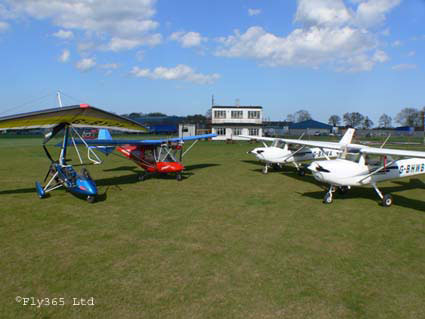
Wickenby Airfield
After the RAF left Wickenby most of the land reverted to farming but the northern part of runways 03/21 & 16/34 (now re-designated 15/33) became Wickenby Aerodrome and are still used today for private flying, along with the Watch Office which serves as a cafe, a club room for the flying schools, aerodrome air traffic control and is also the home of the RAF Wickenby Collection. Flying at Wickenby includes General Aviation, Microlighting, Gyrocopters, Vintage Aircraft and Aerobatics.
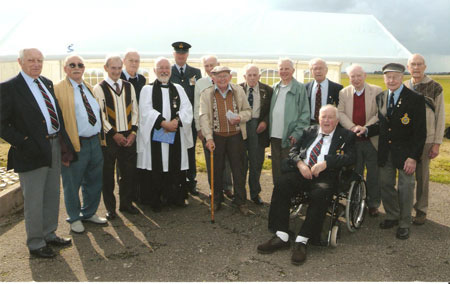
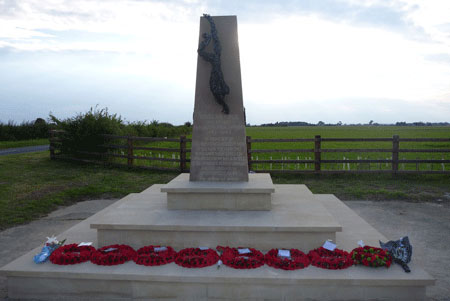
The Wickenby Register
The Wickenby Register (The 12 & 626 Squadron Association) was formed in 1979 by a small group of aircrew who had served with 12 and 626 Squadron’s at Wickenby from 1942-45. Over the next few years founder members Jim MacDonald and Denzil Ede researched the history of the two Squadrons and collected together Operational Record Books, a considerable collection of photographs and a number of Flying Log Books and other documents for safe keeping. These documents form the basis of the Wickenby Archive which will continue to be looked after and added to by the RAF Wickenby Memorial Collection. The Wickenby Register was responsible for the building of the Memorial at the gates to Wickenby Aerodrome and its refurbishment in 2010 and also for the printing of the Book of Remembrance which is housed in the Museum at Wickenby. Over the years a large number of Members, Associate Members and Friends were built up and 32 Reunion Dinners and Memorial Services were held. The Wickenby Register held their final AGM in September 2011 when their members agreed that it would be disbanded and a new committee be set up called “Friends of the Wickenby Archive”, the five members of this committee represent the Airfield, the Wickenby Register and the RAF Wickenby Memorial Collection and their responsibilities are to maintain the memory and heritage of 12 & 626 Squadrons, the safekeeping of the Archive and Book of Remembrance, the maintenance of the Memorial and the organisation of an Annual Memorial Service and to maintain contact with the current 12 Squadron and the ATC.
Wickenby Museum
The Wickenby Museum was originally set up by Julia Mills & Philip Swan during the 1990s when as owners of the airfield at that time they noticed a great deal of interest being shown in its history. After they left the airfield the current volunteers Tim Brett and Anne Law took over the day to day running of the Museum and changed the name to the RAF Wickenby Collection, changing the layout of the Museum, adding informative displays, answering enquiries from the public and digitising the archive. The Collection which has increased quite considerably over the last five years is made up of memorabilia relating to WWII and post-war Wickenby and can be found in the upstairs of the Watch Office overlooking the two remaining runways.
